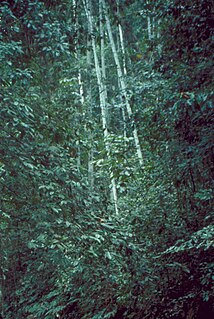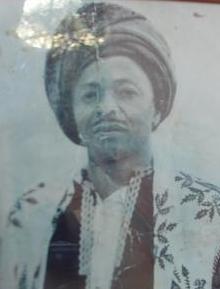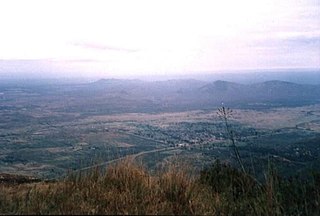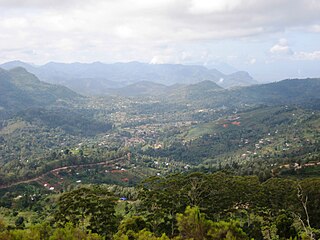Shambhala or Shambala is a mythical kingdom in Tibetan Buddhism. It may also refer to:

The Usambara Mountains of northeastern Tanzania in tropical East Africa, comprise the easternmost ranges of the Eastern Arc Mountains. The ranges of approximately 90 kilometres (56 mi) long and about half that wide, are situated in the Lushoto District of the Tanga Region. They were formed nearly two million years ago by faulting and uplifting, and are composed of Precambrian metamorphic rocks. They are split into two sub-ranges; the West Usambaras being higher than the East Usambaras, which are nearer the coast and receive more rainfall.

The Amani Nature Reserve is a protected area located within the Muheza and Korogwe Districts in the Tanga Region of Tanzania, in tropical East Africa.
The Segeju are an ethnic and linguistic group from Mkinga District, Tanga Region, Tanzania, between the city of Tanga and the Kenyan border. The people are historically related to the Dhaiso. In 2003 the Segeju population was estimated to number fewer than 15,000, with fewer than 7,000 speaking the (ki)Segeju language.. The Segeju have kinship relations with the Digo people, who are part of the nine tribes of the Mijikenda. The Segeju live in two areas namely the coastal and the highlands of the Usambaras. Those that live in the Usambara call their language Dahisu and call themselves Segeju.
The Dhaiso, or Daiso, are an ethnic and linguistic group based at the foot of the Usambara Mountains in the Muheza District of Tanga Region in northeastern Tanzania. In 1999, the Dhaiso population was estimated to number 5,000, and the Dhaiso language is not being transmitted by adults to children. The Dhaiso are historically related to the Segeju, and are sometimes referred to as "Islamized Segeju". The Segeju are also found in the Kwale county of Kenya. Most of their tradition has been heavily influenced by their populous Digo neighbors. The Dhaiso and the Segeju are also historically linked to the Kamba.
The Bondei are an ethnic group based in the Usambara Mountains of Tanga Region in northeastern Tanzania. Bondei speak a Bantu language and are related to the Shambaa ethnic group. Population is roughly 100,000. Most of Bondei people reside in Muheza District where they engage in different activities especially small-scale agriculture.
The Mazumbai warty frog is a species of frogs in the family Brevicipitidae. It is endemic to forests of the West Usambara Mountains of Tanzania where it is threatened by habitat loss. It is part of a species complex and was recognised as a separate species in 2004, having previously been included in Callulina kreffti.

Irente School for the Blind Girls was founded in 1963 by the Lutheran Church in the Usambara Mountains in Lushoto, Tanzania. It is a small residential/primary school. Subjects include craft training and agriculture.

Pangani is a town in northeast Tanzania that lies 45 km south of Tanga, at the mouth of the Pangani River. It is the headquarters of Pangani District.
Nyakyusa, or Nyakyusa-Ngonde, is a Bantu language of Tanzania and Malawi spoken by the Nyakyusa people around the northern end of Lake Malawi. There is no single name for the language as a whole; dialects are Nyakyusa, Ngonde (Konde), Kukwe, Mwamba (Lungulu), and Selya of Tanzania. Disregarding the Bantu language prefixes Iki- and Ki-, the language is also known as Konde ~ Nkhonde, Mombe, Nyekyosa ~ Nyikyusa, and Sochile ~ Sokili.
Mbegha was the first "Lion King" of the Shambaa people, modern-day Northeastern Tanzania, who lived during the first half of the 18th century. While his existence is undisputed among historians, his biography is mainly based on oral traditions. Numerous legends have made him a mythic hero.
The Soni Falls is a waterfall in the Usambara Mountains of northeastern Tanzania, near the village of Soni, to the northeast of Kitunda. The falls lie at the end of the Mkuzu River where it joins the Bangala River. The falls lie in the southern part of the West Usambaras Lushoto Mountain Reserve.

Kimweri ye Nyumbai was the ruler of the Shambaa people of the Usambara Mountains in what is now Tanzania between around 1815 and 1862. Under his rule the kingdom reached its greatest extent. However, disruptions caused by the introduction of firearms and the slave trade caused the kingdom to fall apart after his death.

Kimweri Mputa Magogo was a traditional leader of the Shambaa people of the Usambara Mountains in Tanzania. He was the last of his dynasty to be recognized as having authority, which was removed in 1962.

Mazinde is a community in the Korogwe District of the Tanga Region of Tanzania.

Aloe flexilifolia is a species of flowering plant in the family Asphodelaceae. It is native to the Usambara Mountains, in north-east Tanzania.











